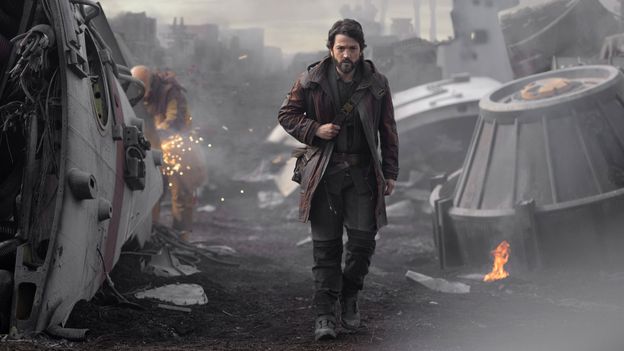Star Wars prequel series is ‘uneven’


Star Wars: Andor, the prequel series to the 2016 film Rogue One, a prequel itself, opens with a sequence that is dark and stylish. Our hero, the doomed rebel Cassian Andor (Diego Luna), has landed on a planet called Morlana One, home to the company town of Preox, in order to seek out information on his missing sister. It is night, and the rain is falling hard. Andor, a shadow making his way through dimly lit streets with neon signs burning through the murk, comes to a place heavily suggested to be a brothel. Later, having left with few answers, he is ambushed by two men. The camera rests on Luna’s face as they approach from behind, rain drumming on his shoulders. He kills one by accident, the other in cold blood.
More like this:
– Why Hollywood has failed Gen Z
– The TV show that sums up our times
– The Rings of Power is ‘staggering’
It is an opening that announces Andor as something a bit grittier, a bit grimmer and more mature than other Star Wars TV projects. Creator Tony Gilroy – best known for his work in adapting the Bourne Trilogy, and for overseeing vital, film-saving reshoots on Rogue One – has said that he wanted Andor to be about “real people”, rather than Skywalker royalty. “There’s a billion, billion, billion other beings in the galaxy,” he told Variety. “What are their lives like? The revolution is affecting them just as much as anybody else. Why not use the Star Wars canon as a host organism for absolutely realistic, passionate, dramatic storytelling?” It’s an intriguing idea, although based on the four episodes made available to critics, Andor is a curiously uneven work: meandering and ponderous in its plotting, striking in its production design and on-location shooting, and ultimately as underwhelming as it is promising.
Set during the height of the Empire, between the events of Revenge of the Sith and A New Hope, Andor tells the story of how Cassian Andor, the cold-hearted rebel first introduced in Rogue One, rose to become a key figure in the Rebellion. The first three episodes, released in a block, introduce him as something quite different: a lowly salvager, with a talent for stealing from the Empire, who now finds himself wanted for murder.
He needs to get off the planet of Ferrix, which mostly takes the form of a rundown town full of giant scrapyards and decaying factories. Unlike other Star Wars Disney+ shows, Andor eschews the Volume – a massive LED screen that is used to create photorealistic backdrops – in favour of a traditional blend of green screen and practical sets/locations. It’s a choice that makes Andor stand out, at least visually, compared to its predecessors. Whereas Obi-Wan Kenobi was plagued by a look that felt too lifeless and limited for the cinematic story it was trying to tell, the practical sets of Andor (if reports are to be believed, the set of Ferrix was essentially a fully functioning town) ground the story in the dirt and grime of the galaxy. It is, by far, the best Star Wars has looked on TV, albeit with the caveat that it is still no match for the lavishness of a Star Wars movie.
Rather than being under direct Imperial control, Ferrix has instead been outsourced to a nebulous corporation. It is an interesting detail – analogous, perhaps, to companies who profited from Nazi collaboration during World War Two – amidst a barrage of dense, disorientating world-building, where characters and concepts are introduced with little to no explanation. It is perhaps a creative choice, an attempt to give the world a sense of richness and lived-in authenticity, but it mostly ends up making its first couple of episodes feel narratively confused and alienating. It certainly doesn’t help either that after Andor’s wonderfully moody and atmospheric opening, the show spends three entire episodes (around 45 minutes each) building up to Cassian’s escape from Ferrix. It’s a three-parter that feels protracted and listlessly paced, almost as if it is an episode too long.
We follow Cassian as he attempts to raise the funds to get off-world by selling a piece of imperial technology. Along the way we’re introduced to various companions and acquaintances, including his unremarkable scrap dealer friend Bix (Adria Arjona), who is trying to arrange a deal with a buyer, and his mentor Maarva, played by the indomitable Fiona Shaw. These scenes are intercut with an investigation by “corpo” zealot Syril Karn (Kyle Soller) – who is accompanied by a sergeant played by the great Alex Fern (Trevor from Eastenders, for the Brits) – and a series of fairly tedious flashbacks to Cassian’s childhood, where he grew up as part of a tribe on a planet ravaged by the Empire.
Stalled start
Episode three, at least, is where things start to happen. This is where we first meet Stellan Skarsgård’s Luthen, who lands on Ferrix to recruit Cassian into the Rebellion. “Don’t you want to fight these bastards for real?” he growls in one stand-out scene. Skarsgård, his voice full of glass and gravel, his grandeur and gravitas undeniable, is just the jump-start the show needs, and his arrival is followed by some much-needed action. However, it is the fourth episode where Andor starts to live up to the promise made by its arresting trailers and marketing (it is presumably why Disney gave critics four episodes instead of the first three).
It is here that we get to the meat of Andor: political intrigue, spycraft and daring Rebel missions. There are scenes set on the capital planet of Coruscant, where Genevieve O’Reilly’s Mon Mothma, a senator destined to lead the Rebel Alliance, finds her every move watched by the Empire. There is a storyline that takes us into the inner workings of the Imperial Security Bureau (ISB), where cold, stiff Imperial officers with English accents talk about order, and navigate internal power struggles. As for Cassian, he has found himself part of a ragtag team who must pull off an impossible heist. It is an episode that also features some spectacular on-location shooting, with shots of TIE Fighters flying over the grand, green vistas of the Scottish Highlands.
Compared to other Star Wars shows, it is a slower, more granular beast, more concerned with talks of space politics over dinner rather than the swishing of lightsabers. But away from the drudgery of Ferrix, the show is finally able to escape orbit, and give us some of the insight into the everyday reality of the galaxy, as described by Gilroy. Whether that means that Andor is Star Wars for grown-ups remains to be seen. There are suggestions of maturity in its tone and aesthetic, but at this stage it’s too early to tell whether the show has the means to explore adult themes in a universe that was constructed for children.
Similarly, it is a tricky task to judge a 12-part series like Andor based on a quartet of uneven episodes. It is a series that starts well, meanders into tedium, gradually improves, and then finishes with an episode that suggests an immense amount of promise. It is like a young Jedi Padawan, so full of glorious possibilities, their talent obvious to everyone, whose future is clouded by the Force. Will they bring new hope to the Star Wars universe, or leave everyone in bitter disappointment? We, at the very least, have faith.
★★★☆☆
Star Wars: Andor is streaming on Disney+ now.
Love film and TV? Join BBC Culture Film and TV Club on Facebook, a community for cinephiles all over the world.
If you would like to comment on this story or anything else you have seen on BBC Culture, head over to our Facebook page or message us on Twitter.
And if you liked this story, sign up for the weekly bbc.com features newsletter, called The Essential List. A handpicked selection of stories from BBC Future, Culture, Worklife and Travel, delivered to your inbox every Friday.















